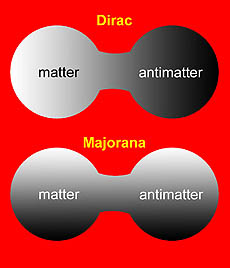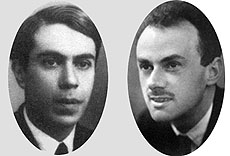Neutrinos: Majorana or Dirac?
 |
| If neutrinos are Dirac particles, their matter and antimatter versions are very different. If they are instead Majorana particles, the matter and antimatter components are the same thing.
|
The neutrino is one of the most mysterious particles in the Standard Model. The original idea of neutrinos was formulated in response to a problem in beta decay, in which a neutron converts into an electron and a proton. (Historically, the electron in this kind of decay has been called a beta particle.) The problem was that energy seemed to disappear in the reaction. Either the principle of energy conservation had gone out the window or a non-interacting particle was emitted in the decay. Wolfgang Pauli proposed the second solution in 1930 in what he called a “desperate remedy.” His original name for this particle was the neutron, but this name was subsequently used to describe the familiar neutron in the nucleus, leading Enrico Fermi to propose neutrino (Italian for “little neutral one”).
Nearly massless, these subatomic ghosts can penetrate anything. Many trillions of neutrinos that originate in the thermonuclear furnace of the Sun pass through you every second of your life. If you filled space from here to the nearest star (about five light-years) with solid lead, you’d stop about half the Sun’s neutrinos. Neutrinos really don’t interact much.
Neutrinos have additional mysteries. For instance, they can morph into one another. Unlike their charged counterparts the electron, muon and tau, which appear to be distinct and immutable particles, the three types of neutrinos can convert back and forth as they travel. We call this behavior neutrino oscillation. Scientists first suspected this behavior based on studies of neutrinos from the Sun and also from cosmic rays. They subsequently confirmed their suspicions in 1998 at the Super Kamiokande experiment in Japan. Since then, active research programs at Fermilab, CERN and KEK, to name a few, have investigated the nature of these neutrino oscillations, and Fermilab is planning to structure a large fraction of its future scientific program around better understanding this phenomenon.
While neutrinos are a fascinating laboratory with which to study the fundamental laws of nature, there is a seemingly simple question about neutrinos that has not yet been answered. This question is, “Are neutrinos and antimatter neutrinos different particles, or the same particle masquerading as two?” In a different Nutshell, we described matter and antimatter. Antimatter is the opposite of matter and will annihilate with matter to create energy. Thus it seems rather odd to ask if neutrinos and antineutrinos are the same particle.
 |
| Ettore Majorana (left) and Paul Dirac (right) proposed two different answers to the question of whether neutrinos and antineutrinos are different particles or a single particle masquerading as two. Nearly a century after neutrinos were proposed, the topic remains an open question.
|
To better understand this, we need to dig a bit deeper in history. In 1957, physicists showed that neutrinos and antineutrinos were different. The difference lies in their subatomic spin. You can, with some poetic license, treat subatomic particles as little spinning balls. Unlike what you might believe based on your intuition, which was formed at large scales, in the microrealm, the axis around which the ball spins can’t point in just any old direction. When we measure the spin in the quantum world, it points in the direction of motion of the particle. This allows us to define the term “handedness” to identify a particle’s spin. Suppose you take a hand and point your thumb in the direction of motion of a particle. The natural curl of your fingers point in a different direction depending on whether you use your right or left hand. Thus if a particle is spinning in the direction pointed at by the fingers of your right hand, we’d say this particle had “right-handed" spin, while if the particle spins in the opposite way, you’d say it had “left-handed" spin.
Neutrinos have left-handed spin and antineutrinos have right-handed spin. This seems to clearly indicate that neutrinos and antineutrinos are different. However, if neutrinos have mass, it is always possible to change your frame of reference so that your direction of motion is reversed.
To understand that, walk along a street in a northerly direction. As you walk, your position becomes “more north” with each step, compared to a streetlamp you pass. However, if a car heading north drives past you, a person in the car will see every second that you are further south from them as they travel. Thus a person standing near the lamppost and a person in the car will disagree as to your direction of motion. These two people would also therefore disagree on a neutrino’s handedness.
If neutrinos have mass (and we know they do, as we have observed neutrino oscillation), one can ask whether a neutrino and antineutrino are one and the same particle. If the two are different, they are called Dirac particles (after Paul Dirac), while if the same, they are called Majorana particles (after Ettore Majorana).
If neutrinos are Majorana particles, this opens up all sorts of new kinds of physics. A kind of radioactive decay called neutrinoless double beta decay is possible. Ordinarily in beta decay, one of the emitted particles is a neutrino (along with an electron). (You will recall that this is how the neutrino was originally imagined.) However if the neutrino can also be an antineutrino, it can be absorbed in a second interaction, which also emits an electron, but leaves no neutrinos to be emitted. Also, if neutrinos are Majorana particles, it is possible to imagine an explanation for why the mass of the neutrino is so small.
—Don Lincoln
Want a phrase defined? Have a question? E-mail today@fnal.gov.
|